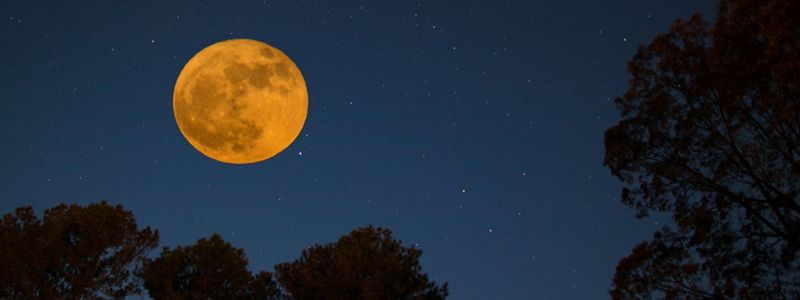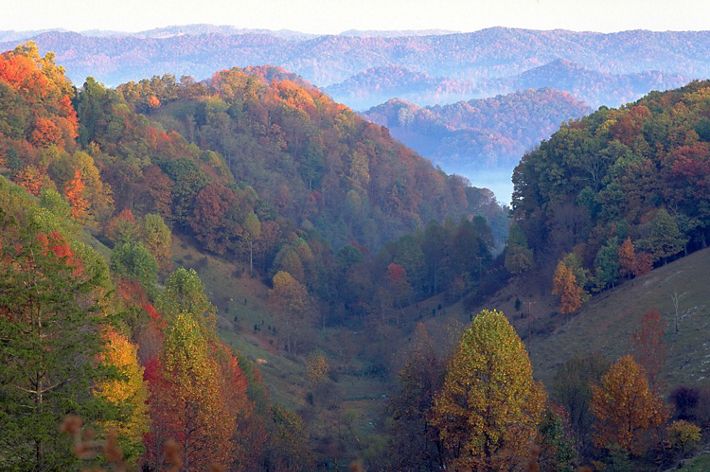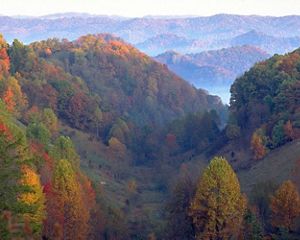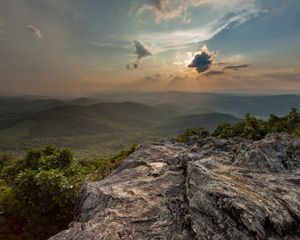Addressing Climate Change in Virginia
Protecting healthy natural systems, developing breakthrough ideas and influencing policy.
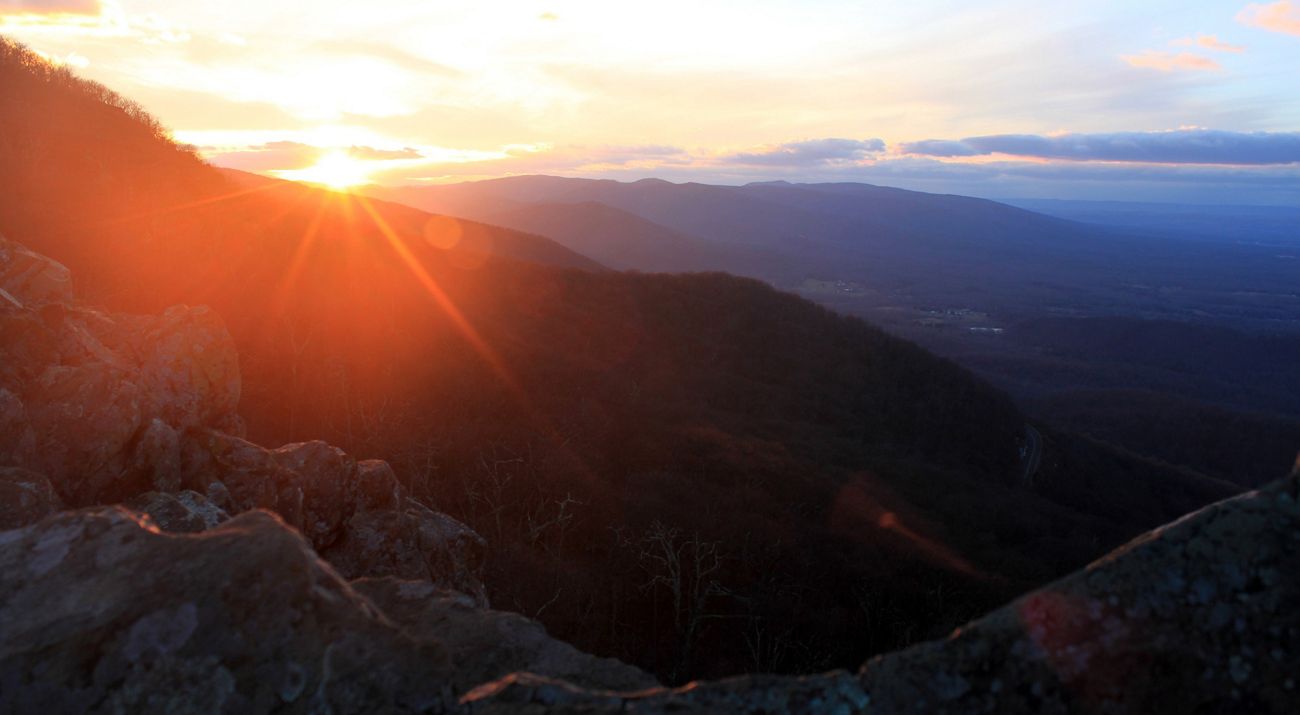
An unstable climate and rising seas threaten the things we care about most: the health of our lands and waters and the well-being and prosperity of our communities.
What we do between now and 2030 will determine whether we slow warming enough to avoid the worst impacts of climate change—while also conserving enough land and water to slow accelerated species loss.
The urgency of the climate crisis demands innovation, and science is telling us that nature must be central to our solutions.
Addressing Climate Change: The Opportunity
Addressing climate change presents opportunities for innovation in all facets of human life—in how we provide clean and affordable energy for communities, design healthy and livable cities, conserve and protect lands and oceans and provide clean and stable water sources for future generations.
New thinking and science in these areas can contribute to healthy lands and waters, prosperous communities and strong economies, while also addressing climate threats.
The Nature Conservancy is promoting practical, innovative solutions to create a prosperous, low-carbon future that is cleaner, healthier and more secure for everyone. Across Virginia, TNC is applying nature-based solutions to address the challenges of climate change. Healthy natural systems, like salt marshes, oyster reefs, seagrass meadows, forests and wetlands, have a better chance of adapting to a changing world.
HOW WE ACHIEVE CHANGE
- We advance policy changes that accelerate the world’s transition to clean energy and increase investment in readily available, cost-effective natural climate solutions.
- We work to protect people and nature on the frontlines of the most vulnerable communities feeling impacts from climate change, by safeguarding coastlines and helping residents adapt to climate-related threats.
- In the United States, we use a nonpartisan, inclusive approach to build bridges across the political spectrum and advance policies to reduce greenhouse gas emissions in all 50 states.
- We work with federal, state and private stakeholders to demonstrate how large-scale forest restoration and improved forest management can generate economic and environmental benefits
Climate change may be one of the most important and difficult challenges humanity has ever faced. But together, we all are part of the solution.
Clean Energy
Mining the Sun: Solar Energy
In May 2021 TNC announced an innovative collaboration with two renewable energy companies that aim to develop some of the first utility-scale solar projects in the Central Appalachian coalfields. Charlottesville-based Sun Tribe and Washington, D.C.-based Sol Systems will build on former coal mines within TNC’s nearly 253,000-acre Cumberland Forest Project.
Much of the optimism around this project is driven by enabling policies passed in Virginia that encourage the development of renewable energy, including solar. Over the past several years, Virginia lawmakers and private business interests have taken great strides towards becoming a leader in the clean energy space.
A big driver of this shift is the Virginia Clean Economy Act (VCEA), which was signed into law in 2020. It calls for Virginia’s electric utilities to produce their electricity from 100 percent carbon-free sources by 2050. The legislation also declares 16,100 megawatts of solar and onshore wind generation facilities to be in the public interest.
Southwest Virginia and the wider Central Appalachian coalfield region is uniquely positioned to support the expansion of renewable energy development with hundreds of reclaimed former surface mines potentially capable of being converted to new solar projects. The effort aims to achieve environmental and economic benefits while creating a blueprint for further coal to solar transformations across the region, demonstrating that a mission of conservation and economic recovery can be compatible.
Smart from the Start: Solar Siting in Virginia
Development of carbon-free electricity generation infrastructure is essential to avoiding the worst impacts of climate change, yet as renewable energy development expands in Virginia, conflicts can arise between important environmental and cultural resources.
TNC has developed a simple solar siting model in order to understand how much land is available for solar development in Virginia and to gauge how challenging it will be to meet the VCEA's renewable energy goals without converting conservation lands such as prime farmlands, biodiversity hotspots, wildlife habitats and regions of cultural or historical importance. Through this we hope to generate ongoing conversations around land use for solar development that bridge the gap between key developers, state agencies, environmental nonprofits and other interested parties.
Carbon Connections
Reducing Carbon Pollution
No one enjoys sitting in traffic. But all those cars and trucks you see on the road—did you know they are the single largest source of carbon dioxide emissions in Virginia? In fact, personal vehicles are responsible for 37% of Virginia’s carbon pollution, far outpacing the entire power sector.
Any hope of avoiding the worst impacts of climate change depends on reducing carbon emissions from the transportation sector.
Fortunately, an achievable solution is available to Virginia. In 2021, the General Assembly passed a set of rules which include low-emission and zero-emission vehicle standards—often called the Clean Cars Standards—to help ensure that more electric vehicles are available for purchase in Virginia and not just in neighboring states. These standards also hold manufacturers to higher emissions standards for the entire fleet of cars sold in Virginia.
Storing Carbon: Healthy Forests
Forests help fight climate change by storing carbon in the roots, trunk, branches and leaves of trees. Since healthy forests absorb more atmospheric carbon than degraded ones, protecting and restoring healthy forests is a key strategy in solving the challenges presented by climate change.
Through our Conservation Forestry Program in southwestern Virginia, we’re working to change the short-term thinking that has plagued Appalachian forest management for at least a century. Rather than viewing their timber as a piggy bank to be broken in an emergency, landowners have banked 22,000 acres of private forestland with our program, earning annual dividends and helping protect clean water.
TNC's Conservation Forestry Program is one example of how creative problem solving has provided much needed conservation funding through carbon markets.
The Benefits of Carbon Markets
Creative problem solving is rewarded through carbon markets. When companies must pay for their carbon dioxide pollution, they have a financial incentive to reduce the amount they pollute. This creates business opportunities for sectors that improve energy efficiency, fuel efficiency, renewable energy options and more.
Carbon offsets, a component of carbon markets, are credits given to projects that remove carbon dioxide or other greenhouse gases from the atmosphere. These projects require money to develop and maintain. Businesses fund these projects through purchasing carbon offsets, and in return, receive credit for the carbon that project removed from the atmosphere.
In 2014 our Conservation Forestry Program became the first TNC project in the nation to earn and sell certified forest-carbon credits under California’s cap-and-trade program. In 2018, we successfully verified 158,905 tons of carbon captured, offsetting emissions from almost 18 million gallons of gasoline.
With California’s legislature extending the program through 2030, market stability will generate increased revenues, which will enable more on-the-ground forest restoration—a big win for climate, habitat and water quality.
Carbon offsets have made our Conservation Forestry Program economically viable and environmentally sustainable. This is just one example of the potential of carbon markets to create new financial opportunities.
Building Resilience
Protecting Coastal Communities
Recent evidence suggests that coastal “blue carbon” projects can be just as effective as forests in curbing carbon. Studies even suggest that coastal wetlands can store three to five times more carbon than a same-size tropical forest.
On Virginia’s Eastern Shore, TNC's Volgenau Virginia Coast Reserve is protecting and restoring marine systems such as oyster reefs not only for their habitat value, but also increasingly because they may counter climate impacts by taking the punch out of storm waves, helping slow the rate of erosion along marsh edges and growing apace with sea-level rise.
Though less visible and less heralded—so far—than oyster reefs, eelgrass meadows comprise a key part of the mosaic of healthy habitats that also serve communities as an early line of defense against erosion, inundation and storms.
From near total collapse during the 1930s, eelgrass in coastal bays off the Eastern Shore has rebounded to cover nearly 9,000 acres since TNC and the Virginia Institute of Marine Science teamed up to launch the world’s largest seagrass restoration project.
Over the last decade, more than 500 volunteers have helped collect millions of seeds to accelerate the return of eelgrass. The eelgrass habitat is healthy enough now to spread on its own, but speeding up natural processes improves nature’s chances of keeping pace with climate change.
Flourishing eelgrass meadows offer a natural alternative to traditional engineering for addressing coastal erosion; capturing carbon emissions; and providing vital habitat for fish, crabs and bay scallops.
If you have questions or concerns regarding our blue carbon seagrass project, please contact Jill Bieri, Volgenau Virginia Coast Reserve Program Director, by phone at 757-442-5416 or email jbieri@tnc.org.
Empowering Communities, Supporting Informed Decisions
The Volgenau Virginia Coast Reserve is an extraordinary living laboratory, advancing scientific understanding of how nature can help coastal communities here and around the world better withstand the effects of our changing climate.
The Coastal Resilience Mapping and Decision Support tool, an interactive online app, collects this knowledge and empowers localities with the information they need to plan for a better future.
Using local data and information, the online decision-support tool incorporates the best available science, allowing communities to visualize the risks imposed by sea-level rise and storm surge and enabling identification of nature-based solutions to mitigate risk and enhance resilience.
Knowing the risks and understanding potential nature-based solutions will empower coastal communities to adapt and thrive for the long term.
Stay In Touch
Sign up to receive monthly conservation news and updates from Virginia. Get a preview of Virginia's Nature News email
